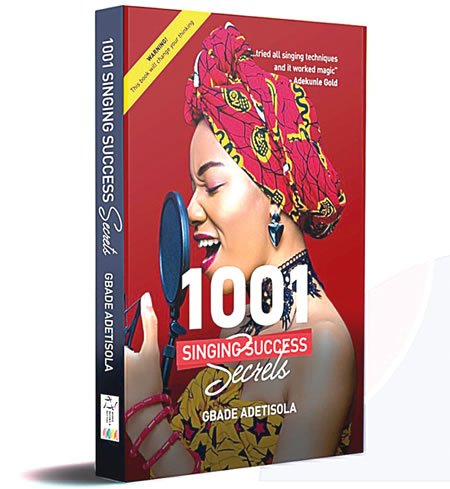What secrets did they tell you about being a successful musician? 1001 Singing Success Secrets offers you a whole more. Call it a manual, a guide, a tutor. Whichever you choose, you are right. The author, Gbade Adetisola, doesn’t waste time in launching into the main business of his book. He leaves the preface to do justice to the preambles. The reader is assured that the writer taking them on a tour is an experienced one. This is a necessary ingredient in teaching. Learning is usually quite enhanced when the person or people learning have solid confidence that the teacher or whoever is dishing out knowledge is an expert and authority in that area. Gbade doesn’t just tell the reader that his book is outstandingly instructive and helpful, he shows it.
The first chapter is dedicated to dismissing myths and unfounded misconceptions about music and singing, especially. Also included are voice training tips, eye-opening guidelines on food, what to drink and the effects, smoking, breath control and things a singer should abstain from as well as practices to be embraced.
In fact, he would devote a whole portion under Chapter 9 to “Myths vs Facts about Performance”. There, readers will likely chuckle at themselves for things they have been doing wrong or be amazed or both.
In its relatively short length of 130 pages, the book covers so much. It manages to pay attention to details with the use of technical terms (like polyps and paresis) and in-depth analysis, headings and subheadings and explanations that are concise. The first the chapter is generously concluded with the author providing five websites for those who would like to know more about voice exercise. This is thematic exhaustive anatomy of singing and the voice.
With the quote, “Listening is the second most important part of an artiste’s capabilities apart from singing”, one realises that the second chapter is thematically well positioned. The reader is taken through concepts that are as nuanced as listening and hearing. Here, it is revealed that listening is quite relative; relative to the ambient situation (like a large audience) and devices involved (headphones, monitor speakers, microphones or absence of enhancements).
Again, the third chapter is aptly opened, “Many times, what makes you a mature singer is what you don’t sing!” The author definitely taunts the reader’s curiosity and that is really tempting, especially when he or she remembers that the chapter’s title is “40 Tips for Auditions” (there are actually 41 or more in total). Specifically speaking, the chapter discusses tips for conducting vocal auditions and tips for entering singing auditions. Some truths in the book may appear to shock certain readers, especially those who prefer ease to rigour. In Chapter 4, we are told, “The convenient key isn’t always the best.”
Only previously did the author advise that audition goers should try to abstain from very popular songs because they tend to have been overdone. Even while dishing out vital instructions that can transform a musician’s craft, the author isn’t too rigid. He chips in humour from time to time as in when advising on choice of audition songs: “Songs are like women’s hairstyles; if it fits Jane, it might not fit Juliana.” Another good example is located in the subsection titled “How Copyrights and Royalties Work” under the last chapter.
1001 Singing Success Secrets would have been like one of those materials that collapse under their own self-conceit if the author hadn’t made enough recommendations and references to texts and things outside of himself and the books. One time he mentions the best book he ever read on singing (Chapter 1), at another he recommends Brett Manning’s YouTube videos (Chapter 4) and Adam Bradley’s book (Chapter 9). The interactive tone promises to enhance comprehension. Gbade Adetisola writes as if he is before a class of music students, asking them to do this and that, “pay attention here” (as in Chapters like the fifth) and even gives assignments.
Again, in Chapter 5, he provides two websites for further reading. All these give us the impression of a veritable teacher. Gbade definitely writes from a place of long-spanning experience and extensive and intensive research, for his illustrations have depth, his explanations the feel of professionalism and his delivery effective. When he delves into the matter of microphones, it feels like you are listening to a sound engineer. When he talks about the physiology of voice and singing, you are listening to a doctor and a scientist at once.
It is this ability to explain an area with the right diction and appropriateness of that area that will make readers take him serious and rate him as an authority.
In the eighth chapter that is dedicated to distinguishing between music as art and music as entertainment, the author opens with a quotable: “Many people make music but some make money.” He takes on an often-contested area of what music is-art. But his readers may not agree with many or some of his arguments, however much they have been enjoying him.
For example, he treats music and art as two different things and appears to denigrate entertainment music.
The chapter titled ‘singer/songwriter success’ may be the favourite or one of such for many readers. The next and last chapter is such a befitting one. It extensively talks down-to-earth about piracy and violation of intellectual property in Nigeria.
Gbade writes, “This is Nigeria where someone tells you ‘Shebi CD is 30 naira? Patapata everything should be N50; so why are you selling at N200?’ Am I selling CD or my intellectual property? Yes, there is piracy in America but its black market. It is not someone selling with ‘yanga’ on the road and boasting it is the original.”
The author goes legal, taking us through the ideal consequences for illicit practices that are taken for granted in Nigeria.
“Do you know that in developed nations, you can’t even sing an artiste’s song for praise worship without copyright permission? Not to talk of recording it as part of your praise medley in an album.”
1001 Secrets of Singing Success does not force itself on you. Rather, it offers instructions from a skilled tutor, advice of an experienced musician. It serves well that unlike some ponderous epistolary manuals, the book uses block-lettered subheadings that are quite helpful in neatly organizing the messages, making them easily comprehensible and unforgettable.
In the end, the book justifies its title, covering a wide range of topics; from how to cope during public performances, music branding and identity, making great songs and song titles, dealing with the microphone, to finding song inspiration and selling music. Beautifully composed!






